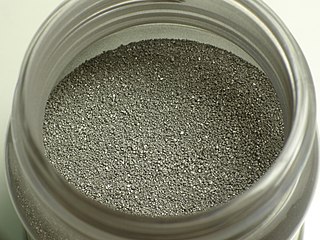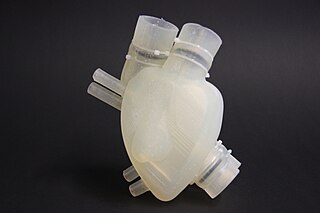Related Research Articles

Powder metallurgy (PM) is a term covering a wide range of ways in which materials or components are made from metal powders. PM processes can avoid, or greatly reduce, the need to use metal removal processes, thereby drastically reducing yield losses in manufacture and often resulting in lower costs.

Selective laser sintering (SLS) is an additive manufacturing (AM) technique that uses a laser as the power source to sinter powdered material, aiming the laser automatically at points in space defined by a 3D model, binding the material together to create a solid structure. It is similar to selective laser melting; the two are instantiations of the same concept but differ in technical details. SLS is a relatively new technology that so far has mainly been used for rapid prototyping and for low-volume production of component parts. Production roles are expanding as the commercialization of AM technology improves.

Stereolithography is a form of 3D printing technology used for creating models, prototypes, patterns, and production parts in a layer by layer fashion using photochemical processes by which light causes chemical monomers and oligomers to cross-link together to form polymers. Those polymers then make up the body of a three-dimensional solid. Research in the area had been conducted during the 1970s, but the term was coined by Chuck Hull in 1984 when he applied for a patent on the process, which was granted in 1987. Stereolithography can be used to create prototypes for products in development, medical models, and computer hardware, as well as in many other applications. While stereolithography is fast and can produce almost any design, it can be expensive.

3D printing, or additive manufacturing, is the construction of a three-dimensional object from a CAD model or a digital 3D model. The term "3D printing" can refer to a variety of processes in which material is deposited, joined or solidified under computer control to create a three-dimensional object, with material being added together, typically layer by layer.
Laser powder forming, also known by the proprietary name is an additive manufacturing technology developed for fabricating metal parts directly from a computer-aided design (CAD) solid model by using a metal powder injected into a molten pool created by a focused, high-powered laser beam. This technique is also equivalent to several trademarked techniques that have the monikers direct metal deposition (DMD), and laser consolidation (LC). Compared to processes that use powder beds, such as selective laser melting (SLM) objects created with this technology can be substantially larger, even up to several feet long.

Organ printing utilizes techniques similar to conventional 3D printing where a computer model is fed into a printer that lays down successive layers of plastics or wax until a 3D object is produced. In the case of organ printing, the material being used by the printer is a biocompatible plastic. The biocompatible plastic forms a scaffold that acts as the skeleton for the organ that is being printed. As the plastic is being laid down, it is also seeded with human cells from the patient's organ that is being printed for. After printing, the organ is transferred to an incubation chamber to give the cells time to grow. After a sufficient amount of time, the organ is implanted into the patient.

3D Systems, headquartered in Rock Hill, South Carolina, is a company that engineers, manufactures and sells 3D printers, 3D printing materials, 3D scanners, and offers a 3D printing service. Chuck Hull, the CTO and former president, pioneered stereolithography and obtained a patent for the technology in 1986. The company creates product concept models, precision and functional prototypes, master patterns for tooling, as well as production parts for direct digital manufacturing. It uses proprietary processes to fabricate physical objects using input from computer-aided design and manufacturing software, or 3D scanning and 3D sculpting devices.
Titanium powder metallurgy (P/M) offers the possibility of creating net shape or near net shape parts without the material loss and cost associated with having to machine intricate components from wrought billet. Powders can be produced by the blended elemental technique or by pre-alloying and then consolidated by metal injection moulding, hot isostatic pressing, direct powder rolling or laser engineered net shaping.
Digital modeling and fabrication is a design and production process that combines 3D modeling or computing-aided design (CAD) with additive and subtractive manufacturing. Additive manufacturing is also known as 3D printing, while subtractive manufacturing may also be referred to as machining, and many other technologies can be exploited to physically produce the designed objects.

Selective laser melting (SLM), also known as direct metal laser melting (DMLM) or laser powder bed fusion (LPBF), is a rapid prototyping, 3D printing, or additive manufacturing (AM) technique designed to use a high power-density laser to melt and fuse metallic powders together. To many, SLM is considered to be a subcategory of selective laser sintering (SLS). The SLM process has the ability to fully melt the metal material into a solid three-dimensional part unlike SLS.

Binder jet 3D printing, known variously as "Powder bed and inkjet" and "drop-on-powder" printing, is a rapid prototyping and additive manufacturing technology for making objects described by digital data such as a CAD file. Binder jetting is one of the seven categories of additive manufacturing processes according to ASTM and ISO.
Solid Concepts, Inc. is a custom manufacturing company engaged in engineering, manufacturing, production, and prototyping. The company is headquartered in Valencia, California, in the Los Angeles County area, with six other facilities located around the United States. Solid Concepts is an additive manufacturing service provider as well as a major manufacturer of business products, aerospace, unmanned systems, medical equipment and devices, foundry cast patterns, industrial equipment and design, and transportation parts.

Fused filament fabrication (FFF), also known as fused deposition modeling, or called filament freeform fabrication, is a 3D printing process that uses a continuous filament of a thermoplastic material. Filament is fed from a large spool through a moving, heated printer extruder head, and is deposited on the growing work. The print head is moved under computer control to define the printed shape. Usually the head moves in two dimensions to deposit one horizontal plane, or layer, at a time; the work or the print head is then moved vertically by a small amount to begin a new layer. The speed of the extruder head may also be controlled to stop and start deposition and form an interrupted plane without stringing or dribbling between sections. "Fused filament fabrication" was coined by the members of the RepRap project to give a phrase that would be legally unconstrained in its use, under the mistaken belief that a trademark protected the term "fused deposition modeling".
Rule based DFM analysis for direct metal laser sintering. Direct metal laser sintering (DMLS) is one type of additive manufacturing process that allows layer by layer printing of metal parts having complex geometries directly from 3D CAD data. It uses a high-energy laser to sinter powdered metal under computer control, binding the material together to create a solid structure. DMLS is a net shape process and allows the creation of highly complex and customized parts with no extra cost incurred for its complexity.
3D metal moulding, also referred to as metal injection moulding or (MIM), is used to manufacture components with complex geometries. The process uses a mixture of metal powders and polymer binders – also known as "feedstock" – which are then injection-moulded.

In recent years, 3D printing has developed significantly and can now perform crucial roles in many applications, with the most important being manufacturing, medicine, architecture, custom art and design.

A variety of processes, equipment, and materials are used in the production of a three-dimensional object via additive manufacturing. 3D printing is also known as additive manufacturing, therefore the numerous available 3D printing process tend to be additive in nature with a few key differences in the technologies and the materials used in this process.
Desktop Metal is a public American technology company that designs and markets 3D printing systems. Headquartered in Burlington, Massachusetts, the company has raised $438 million in venture funding since its founding from investors such as Google Ventures, BMW, and Ford Motor Company. Desktop Metal launched its first two products in April 2017: the Studio System, a metal 3D printing system catered to engineers and small production runs, and the Production System, intended for manufacturers and large-scale printing. In November 2019, the company launched two new printer systems: the Shop System is designed for machine shops, and its Fiber industrial-grade composites printer uses automated fiber placement. Valued at $1.5 billion, Desktop Metal is tied as the fastest growing "unicorn" in United States history. The World Economic Forum named Desktop Metal a Technology Pioneer in 2017.
Cold Spray Additive Manufacturing (CSAM) is a particular application of the cold spraying able to fabricate freestanding parts or to build features on existing components. During the process, fine powder particles are accelerated in a high-velocity compressed gas stream, and upon the impact on a substrate or backing plate, deform and bond together creating a layer. Moving the nozzle over a substrate repeatedly, a deposit is building up layer-by-layer, to form a part or component. If an industrial robot or computer controlled manipulator controls the spray gun movements, complex shapes can be created. To achieve 3D shape, there are two different approaches. First to fix the substrate and move the cold spray gun/nozzle using a robotic arm, the second one is to move the substrate with a robotic arm, and keep the spray-gun nozzle fixed. There is also a possibility to combine these two approaches either using two robotic arms or other manipulators. The process always requires a substrate and uses only powder as raw material.
3D food printing is the process of manufacturing food products using a variety of additive manufacturing techniques. Most commonly, food grade syringes hold the printing material, which is then deposited through a food grade nozzle layer by layer. The most advanced 3D food printers have pre-loaded recipes on board and also allow the user to remotely design their food on their computers, phones or some IoT device. The food can be customized in shape, color, texture, flavor or nutrition, which makes it very useful in various fields such as space exploration and healthcare.
References
- C. J. Tuck; R. J. M. Hague; M. Ruffo; M. Ransley; P. Adams (2007). "Rapid manufacturing facilitated customization". International Journal of Computer Integrated Manufacturing.Missing or empty
|url=(help) - Guerrits, Anton; Lewis Jones, Chris; Valero, Rafael. (2006). "Volume 9". Custom-Fit: Quality of Life of European Sporting Public through Custom-Fit products. The Engineering of Sports 6 - Developments for innovation, Springer London. pp. 229–249. doi:10.1007/BF02866061. S2CID 195338646. 10.1007/BF02866061.
- Ong, Min Huey; Wagner, Helen; Tuck, Christopher; Hague, Richard (2008). "Body-fitting customisation of Motorcycle seats: an investigation of consumer requirements". International Journal of Mass Customisation. 2 (3–4): 375–393. doi:10.1504/IJMASSC.2008.017149.
- H. Wagner; A. Dainty; R. Hague; C. Tuck; M. H. Ong (2007). "The effects of new technology adoption on employee skills in the prosthetics profession" (PDF). International Journal of Production Research. 1. 46 (22): 6461–6478. doi:10.1080/00207540701432623. S2CID 109204241. 10.1080/00207540701432623.
- Chris Tuck; Min Huey Ong; Helen Wagner; Richard Hague (October 2007). "Extreme Customization: Rapid Manufacturing Products that Enhance the Consumer" (PDF). 4th Interdisciplinary World Congress on Mass Customization and Personalization. Retrieved 2008-01-30.
- Dolinsek, Slavko (2007). "Aplikacije hitre izdelave v medicini –projekt Custom-fit". Irt3000. 11 (5): 56–58.[ permanent dead link ]